Picture stepping into two contrasting rooms: one radiates warmth and brightness, while the other lurks in shadows. Instinctively, you gravitate towards the well-lit space, feeling invited and at ease. This simple principle extends to supermarkets, where effective lighting transforms the shopping experience. Let’s explore why lighting is a pivotal element in supermarket design and how it shapes the overall shopping experience.
When you step into a supermarket, it’s not just the layout and the way products are arranged that grabs your attention. One of the less obvious but equally impactful elements is the lighting, which plays a significant role in shaping the shopping experience. Different sections of the supermarket use varied lighting styles, each designed to showcase products in the best possible way. Thoughtful lighting enhances the store’s overall aesthetic, making items more appealing and influencing customers’ purchasing decisions.
Reach out for free lighting consultation
Table of Contents
ToggleImagine being faced with two rooms: one well-lit and inviting, the other dark and shadowy. Instinctively, you’re more likely to enter the well-lit room. The same principle applies to supermarkets. Shoppers are drawn to brightly lit spaces that feel open and welcoming. Beyond just human psychology, there are several reasons why lighting is a crucial aspect of supermarket design.
A supermarket with well-planned lighting has a noticeable appeal. Bright, welcoming lights make the space feel alive and inviting. This initial positive impression can draw in more customers. The inviting glow of the lights gives off a perception of quality and care, encouraging shoppers to explore the store further.

When you walk through a supermarket, you might notice how items like fresh produce or beverages are highlighted by strategically placed lighting. This is no accident. Well-illuminated shelves make the products stand out, enhancing their colors and making them more attractive to potential buyers. Customers are more likely to choose products that appear fresh and vibrant under good lighting, which significantly influences purchasing behavior.
A well-lit supermarket enhances the customer experience by making navigation easier and more pleasant. Proper lighting guides customers through various sections of the store, ensuring they don’t miss important areas or items. In fact, better lighting can lead to longer store visits, as customers are more comfortable and engaged in the environment, potentially leading to higher sales.

When products are well-lit, their colors and textures become more defined, tempting shoppers to pick them up. For example, bright lighting can make fresh produce look more appealing, or pastries in the bakery section appear irresistible. The right lighting subtly convinces shoppers that these products are worth adding to their baskets.
Beyond aesthetics, smart lighting design can also reduce energy costs. Modern supermarkets increasingly use LED lighting, which is both energy-efficient and long-lasting. Investing in a well-planned lighting system not only enhances the store’s atmosphere but also reduces electricity bills and maintenance costs over time.
With the significance of lighting established, let’s delve into how different areas of the supermarket can benefit from tailored lighting strategies.
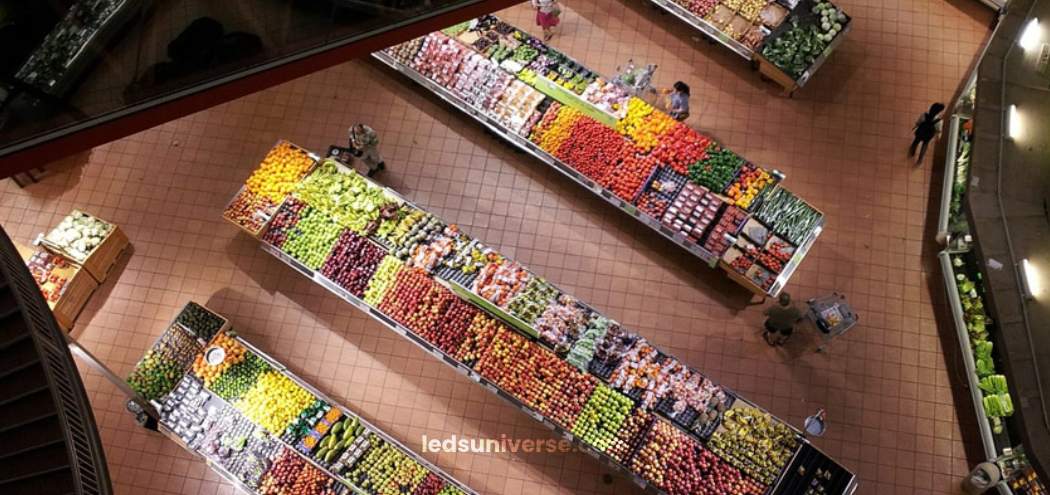
Different sections of a supermarket require specific lighting to highlight the products they contain. Depending on the type of items being displayed, the lighting setup should be adjusted to bring out the best in each category.
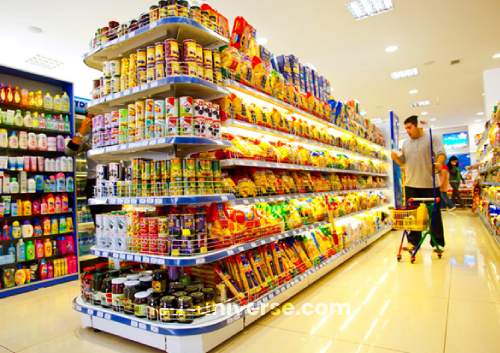
This section is typically organized with rows of parallel shelves that stretch down long aisles, making effective lighting essential for both visibility and navigation. Proper lighting in this space must strike a balance: it should illuminate the shelves sufficiently while also ensuring that customers can move through the aisles comfortably.
In terms of lighting ratios, a common guideline is to achieve a balance of 2:1 for vertical to horizontal lighting. This approach helps highlight the product packaging clearly, making it easy for customers to locate specific items and assess their options. The light should enhance colors and details on the packaging, capturing shoppers’ attention and enticing them to explore further. The strategic placement of lights—whether in overhead fixtures or shelf-mounted LEDs—can reduce shadows and ensure that every product shines, ultimately improving the shopping experience.
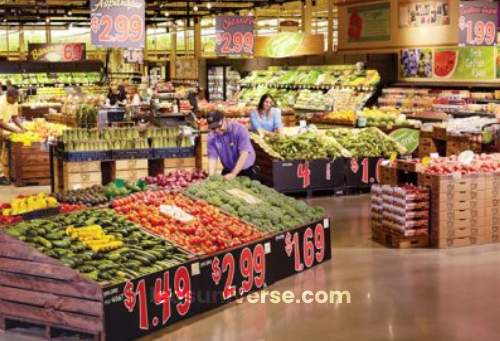
When it comes to sections featuring perishable items such as fruits and vegetables, the role of lighting becomes even more significant. These areas are often the focal point for many shoppers, as customers seek out fresh produce to enhance their meals. Bright, directional lighting is typically employed in these sections, with a preference for warm white lights that evoke feelings of freshness and quality.
The appearance of produce under well-planned lighting can influence purchasing decisions considerably. When fruits and vegetables are lit properly, they appear vibrant, colorful, and appealing, creating an impression of high quality and freshness. Shoppers are far more inclined to purchase items that look well-maintained, and the right lighting can play a pivotal role in creating that visual effect. Additionally, lighting can be designed to emphasize the natural textures of the produce, making them more inviting and enticing.
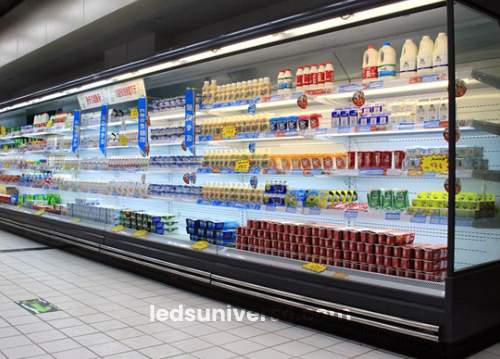
Refrigerated areas dedicated to items like dairy products, fish, and meat require specialized lighting solutions to enhance the presentation of these items. Cool white lighting is typically favored in these sections, aligning with the cold environment while helping to showcase the freshness and quality of the products.
In many cases, lighting fixtures are installed directly inside the refrigerators, ensuring that even items tucked away behind glass doors remain visually appealing to customers. This internal lighting is crucial for showcasing the freshness of products, such as milk or freshly cut meat, helping to create a visual connection between quality and presentation. Customers are more likely to feel confident in their purchase when they can see clearly the items they are buying, supported by well-placed, efficient lighting.

The bakery section of a supermarket presents a unique opportunity to create an inviting atmosphere through lighting. Displaying freshly baked bread, cakes, and pastries, this area benefits from soft, warm lighting that enhances the appeal of baked goods. The warmth of the light can evoke a sense of comfort and freshness, which is particularly important given that many baked goods are purchased impulsively.
Effective lighting in this section encourages customers to linger and admire the beautifully presented items, heightening the likelihood of spontaneous purchases. Well-designed displays combined with the right lighting create a sensory experience that can trigger cravings, prompting customers to choose a delicious pastry or loaf of bread almost on a whim. The objective is to make these products look as tempting as possible, inviting shoppers to indulge.
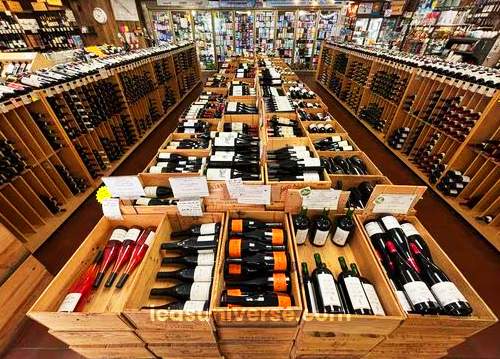
Supermarkets that feature wine and liquor sections often carry a range of premium products that deserve special attention. In these areas, sophisticated lighting can significantly enhance the atmosphere, emphasizing the elegance and high quality of the bottles on display. A carefully crafted combination of warm ambient lighting and targeted accent lighting can create a luxurious feel, drawing customers in and encouraging exploration.
Highlighting the textures of the bottles through effective lighting not only elevates the aesthetic appeal but also creates an alluring environment that entices customers to consider purchases they may not have originally intended. Thoughtfully designed lighting can transform a simple display into a captivating showcase, prompting customers to explore different varieties and brands, enhancing their overall shopping experience.
While specific sections of a supermarket require focused lighting, it is equally important that the overall store lighting maintains a harmonious balance. General illumination should be consistent throughout the store, ensuring that all areas are well-lit without overwhelming customers. Subtle ambient lighting creates a welcoming environment, making shoppers feel comfortable as they navigate through the aisles.
The design should incorporate lighting that supports the store’s layout and flow, guiding customers effortlessly from one section to another. Effective general lighting should not only facilitate easy navigation but also foster an inviting atmosphere that encourages longer visits. The key is to strike a balance: the lighting should be bright enough to illuminate products and pathways clearly, yet soft enough to avoid causing strain or discomfort. This careful consideration contributes to a pleasant shopping environment, encouraging customers to explore and enjoy their experience.
Planning lighting for any commercial space is a significant aspect of interior design. In supermarkets, the goal is to create an environment that is both functional and aesthetically pleasing. Below are some creative lighting strategies to ensure your supermarket stands out.
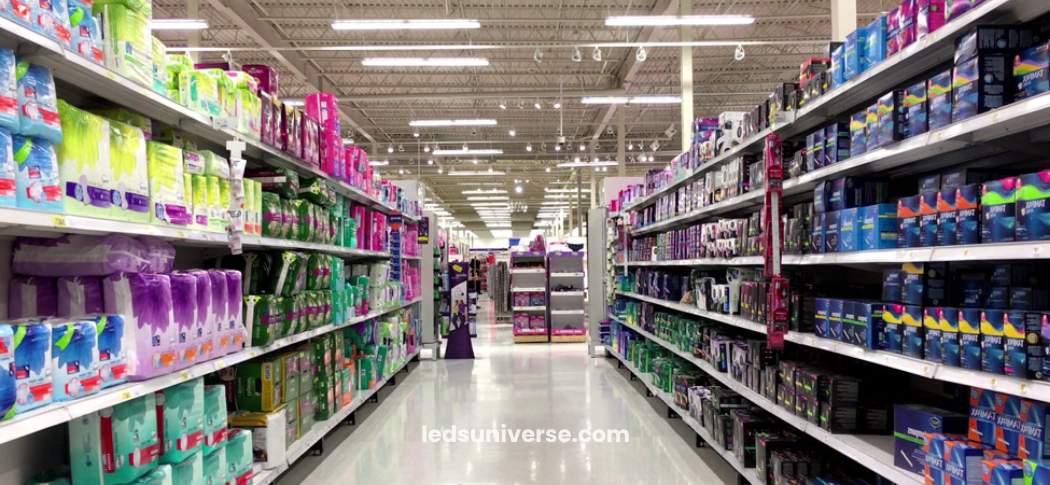
Ambient lighting is the backbone of a well-lit supermarket. It should cover all common areas, including corridors and aisles, to provide a consistent level of brightness. Ceiling-mounted fixtures, recessed lighting, or suspended LED lights are often used to create an even distribution of light. The goal is to ensure that the general store area is well-lit, providing customers with a comfortable shopping experience.
 Accent lighting is perfect for drawing attention to specific products, promotional displays, or sections of the store. This type of lighting is directional and can be used to spotlight items that need extra attention, such as seasonal products or sale items. It helps create focal points within the supermarket, subtly guiding the customer’s gaze towards high-priority areas.
Accent lighting is perfect for drawing attention to specific products, promotional displays, or sections of the store. This type of lighting is directional and can be used to spotlight items that need extra attention, such as seasonal products or sale items. It helps create focal points within the supermarket, subtly guiding the customer’s gaze towards high-priority areas.
Task lighting is useful for sections that require more focused illumination, such as the bakery or fresh produce sections. By placing lights directly above or inside food displays, you can create a striking visual effect that enhances the appearance of the products. Task lighting can also be used in other areas, such as deli counters, where customers need a clear view of the items being prepared and displayed.
Now that we’ve explored different lighting strategies for various sections of the supermarket, here are a few additional tips to help you plan your supermarket lighting more effectively:
LED lighting is not only energy-efficient but also versatile, making it ideal for supermarkets. These lights last longer, consume less energy, and produce less heat compared to traditional lighting options. LEDs are also available in various color temperatures, allowing you to customize the lighting based on the needs of each supermarket section.
Installing motion sensors in less frequently used areas, such as storage rooms or employee-only sections, can help reduce energy consumption. These sensors ensure that lights are only on when needed, providing a cost-effective solution for supermarket lighting.
Using adjustable lighting fixtures can give you greater flexibility in managing the lighting of specific areas. These fixtures allow you to change the direction or intensity of the light, making it easy to adapt to seasonal displays or changes in store layout.
Where possible, incorporate natural light into your supermarket design. Large windows or skylights can bring in daylight, creating a more natural shopping environment. When combined with artificial lighting, natural light helps reduce energy costs and enhances the overall ambiance of the store.
The rapid advancement of lighting technology offers supermarkets a variety of options to optimize their lighting systems. Modern lighting solutions not only improve the overall aesthetics and functionality of a store but also offer practical benefits, such as energy efficiency and customizable controls.
Smart lighting systems are becoming increasingly popular in supermarkets as they allow for dynamic control over the lighting environment. These systems enable the adjustment of lighting levels, color temperatures, and even light direction, all from a centralized control panel or via automation.
For instance, smart lighting can automatically dim or brighten based on the time of day, reducing energy consumption during off-peak hours and enhancing brightness during peak shopping times. Additionally, smart systems can integrate with motion sensors to turn lights on only when customers are present in specific areas, further reducing energy waste.
Supermarkets often change their product displays based on seasonal trends, holidays, or special promotions. Dynamic lighting can be an excellent tool to complement these changes. By using adjustable lighting fixtures, supermarkets can alter the focus and intensity of light to highlight new displays or promotions without needing to redesign the entire store’s lighting setup.
This flexibility allows supermarkets to remain visually engaging throughout the year, ensuring that customers are always met with fresh, exciting displays that catch their attention and drive purchases.
With growing emphasis on sustainability and reducing carbon footprints, energy-efficient lighting solutions are becoming a priority for supermarkets. Implementing eco-friendly lighting systems can significantly reduce electricity consumption while still providing the necessary brightness and visual appeal.
Switching to energy-efficient lighting such as LED systems can dramatically cut a supermarket’s overall energy usage. LEDs consume up to 80% less energy than traditional incandescent bulbs and last much longer, which means fewer replacements and reduced waste. By investing in energy-efficient lighting, supermarkets not only lower their operational costs but also contribute to a more sustainable business model.
Some supermarkets are going a step further by incorporating renewable energy sources, such as solar power, into their lighting systems. Solar panels can be used to power the lighting in certain sections of the supermarket, reducing dependency on traditional power sources. By combining energy-efficient lighting with renewable energy, supermarkets can make a substantial impact on their environmental footprint.
Many countries have energy efficiency standards and certifications that supermarkets can pursue to demonstrate their commitment to sustainability. For instance, lighting systems that meet certain energy-efficiency criteria can earn certifications such as ENERGY STAR, which is recognized by customers and can enhance the store’s brand image as a sustainable business.
The role of lighting in supermarket design is far more than just illuminating spaces. It influences customer behavior, enhances the appeal of products, and creates a welcoming atmosphere that encourages shoppers to explore the store more thoroughly. Effective lighting has a direct impact on sales and can elevate the overall shopping experience, making customers feel more comfortable, engaged, and satisfied.
By incorporating various lighting techniques—whether it’s ambient lighting for general spaces, accent lighting for product displays, or task lighting for specific sections—supermarkets can create an environment that is both functional and aesthetically pleasing. Moreover, modern advancements in lighting technology, such as LED lights and smart systems, offer significant advantages in terms of energy efficiency and cost savings.